air condition KIA Soul 2014 2.G Owner's Manual
[x] Cancel search | Manufacturer: KIA, Model Year: 2014, Model line: Soul, Model: KIA Soul 2014 2.GPages: 500, PDF Size: 13.89 MB
Page 17 of 500
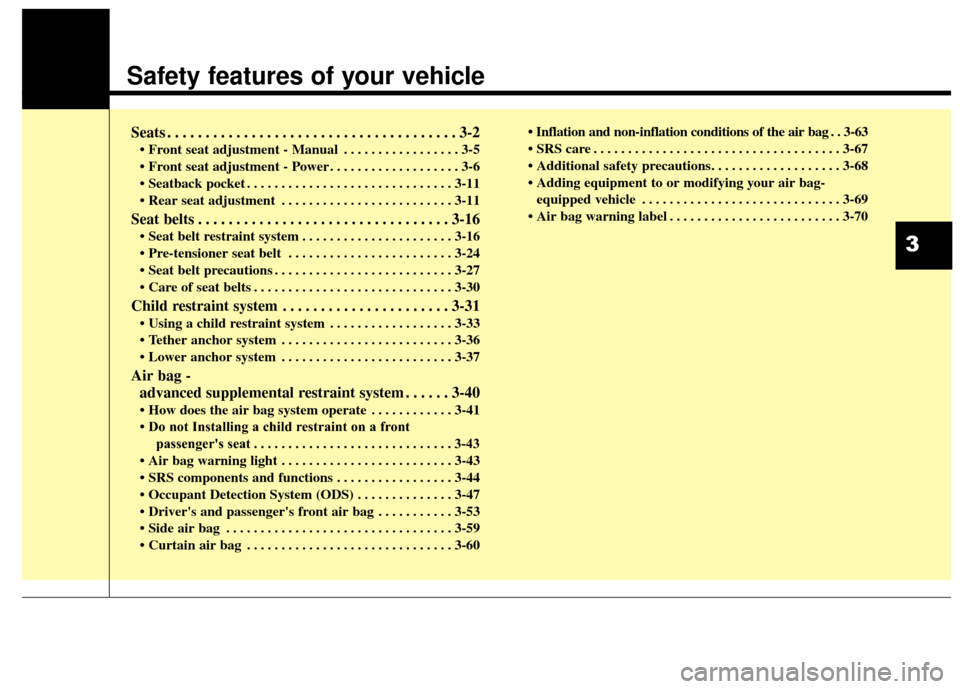
Safety features of your vehicle
Seats . . . . . . . . . . . . . . . . . . . . . . . . . . . . . . . . . . . . \
. . 3-2
• Front seat adjustment - Manual . . . . . . . . . . . . . . . . . 3-5
• Front seat adjustment - Power . . . . . . . . . . . . . . . . . . . 3-6
• Seatback pocket . . . . . . . . . . . . . . . . . . . . . . . . . . . . . . 3-11
• Rear seat adjustment . . . . . . . . . . . . . . . . . . . . . . . . . 3-11
Seat belts . . . . . . . . . . . . . . . . . . . . . . . . . . . . . . . . . 3-16
• Seat belt restraint system . . . . . . . . . . . . . . . . . . . . . . 3-16
• Pre-tensioner seat belt . . . . . . . . . . . . . . . . . . . . . . . . 3-24
• Seat belt precautions . . . . . . . . . . . . . . . . . . . . . . . . . . 3-27
• Care of seat belts . . . . . . . . . . . . . . . . . . . . . . . . . . . . . 3-30
Child restraint system . . . . . . . . . . . . . . . . . . . . . . 3-31
• Using a child restraint system . . . . . . . . . . . . . . . . . . 3-33
• Tether anchor system . . . . . . . . . . . . . . . . . . . . . . . . . 3-36
• Lower anchor system . . . . . . . . . . . . . . . . . . . . . . . . . 3-37
Air bag -
advanced supplemental restraint system . . . . . . 3-40
• How does the air bag system operate . . . . . . . . . . . . 3-41
• Do not Installing a child restraint on a front passenger's seat . . . . . . . . . . . . . . . . . . . . . . . . . . . . . 3-43
• Air bag warning light . . . . . . . . . . . . . . . . . . . . . . . . . 3-43
• SRS components and functions . . . . . . . . . . . . . . . . . 3-44
• Occupant Detection System (ODS) . . . . . . . . . . . . . . 3-47
• Driver's and passenger's front air bag . . . . . . . . . . . 3-53
• Side air bag . . . . . . . . . . . . . . . . . . . . . . . . . . . . . . . . . 3-59
• Curtain air bag . . . . . . . . . . . . . . . . . . . . . . . . . . . . . . 3-60 •
Inflation and non-inflation conditions of the air bag . . 3-63
• SRS care . . . . . . . . . . . . . . . . . . . . . . . . . . . . . . . . . . . . \
3-67
• Additional safety precautions. . . . . . . . . . . . . . . . . . . 3-68
• Adding equipment to or modifying your air bag-
equipped vehicle . . . . . . . . . . . . . . . . . . . . . . . . . . . . . 3-69
• Air bag warning label . . . . . . . . . . . . . . . . . . . . . . . . . 3-70
3
Page 49 of 500
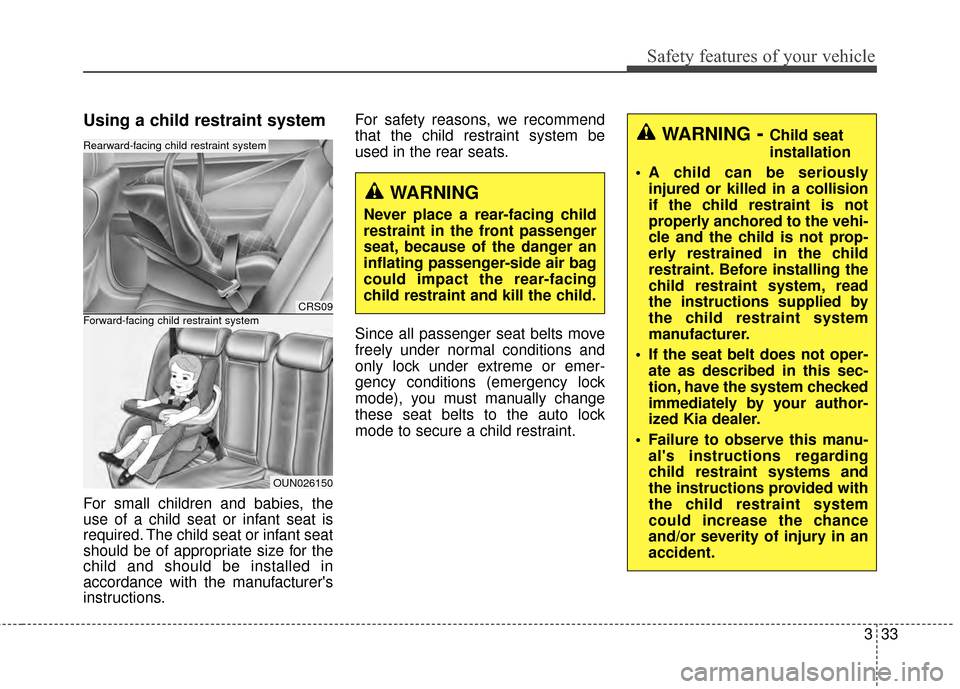
333
Safety features of your vehicle
Using a child restraint system
For small children and babies, the
use of a child seat or infant seat is
required. The child seat or infant seat
should be of appropriate size for the
child and should be installed in
accordance with the manufacturer's
instructions.For safety reasons, we recommend
that the child restraint system be
used in the rear seats.
Since all passenger seat belts move
freely under normal conditions and
only lock under extreme or emer-
gency conditions (emergency lock
mode), you must manually change
these seat belts to the auto lock
mode to secure a child restraint.
CRS09
OUN026150
Forward-facing child restraint system
Rearward-facing child restraint system
WARNING
Never place a rear-facing child
restraint in the front passenger
seat, because of the danger an
inflating passenger-side air bag
could impact the rear-facing
child restraint and kill the child.
WARNING- Child seat
installation
A child can be seriously injured or killed in a collision
if the child restraint is not
properly anchored to the vehi-
cle and the child is not prop-
erly restrained in the child
restraint. Before installing the
child restraint system, read
the instructions supplied by
the child restraint system
manufacturer.
If the seat belt does not oper- ate as described in this sec-
tion, have the system checked
immediately by your author-
ized Kia dealer.
Failure to observe this manu- al's instructions regarding
child restraint systems and
the instructions provided with
the child restraint system
could increase the chance
and/or severity of injury in an
accident.
Page 63 of 500
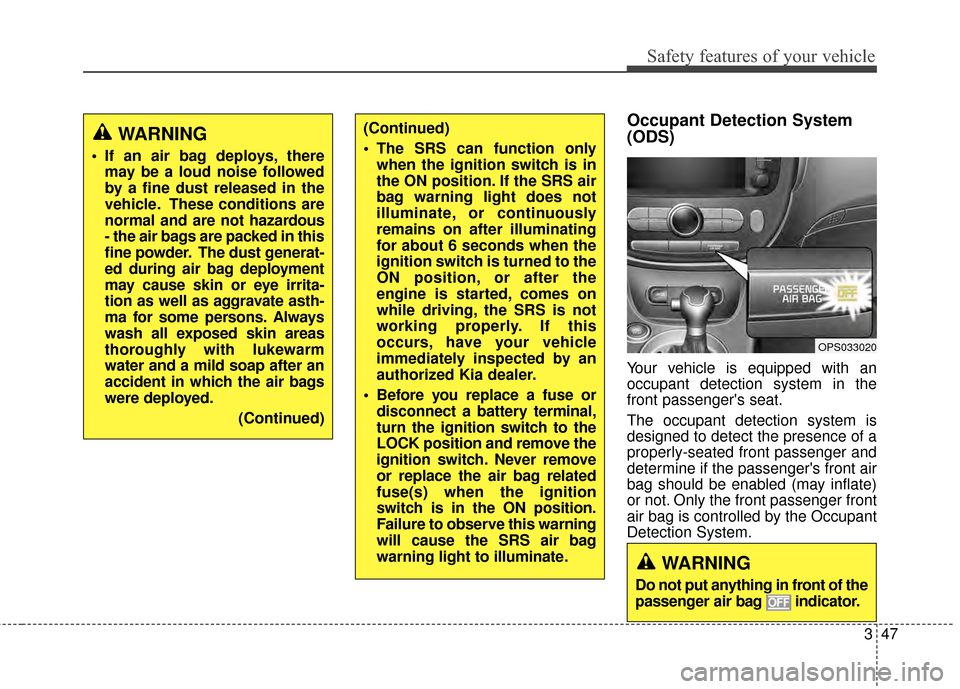
347
Safety features of your vehicle
Occupant Detection System
(ODS)
Your vehicle is equipped with an
occupant detection system in the
front passenger's seat.
The occupant detection system is
designed to detect the presence of a
properly-seated front passenger and
determine if the passenger's front air
bag should be enabled (may inflate)
or not. Only the front passenger front
air bag is controlled by the Occupant
Detection System.
WARNING
If an air bag deploys, theremay be a loud noise followed
by a fine dust released in the
vehicle. These conditions are
normal and are not hazardous
- the air bags are packed in this
fine powder. The dust generat-
ed during air bag deployment
may cause skin or eye irrita-
tion as well as aggravate asth-
ma for some persons. Always
wash all exposed skin areas
thoroughly with lukewarm
water and a mild soap after an
accident in which the air bags
were deployed.
(Continued)
(Continued)
The SRS can function onlywhen the ignition switch is in
the ON position. If the SRS air
bag warning light does not
illuminate, or continuously
remains on after illuminating
for about 6 seconds when the
ignition switch is turned to the
ON position, or after the
engine is started, comes on
while driving, the SRS is not
working properly. If this
occurs, have your vehicle
immediately inspected by an
authorized Kia dealer.
Before you replace a fuse or disconnect a battery terminal,
turn the ignition switch to the
LOCK position and remove the
ignition switch. Never remove
or replace the air bag related
fuse(s) when the ignition
switch is in the ON position.
Failure to observe this warning
will cause the SRS air bag
warning light to illuminate.
OPS033020
WARNING
Do not put anything in front of the
passenger air bag indicator.
Page 64 of 500
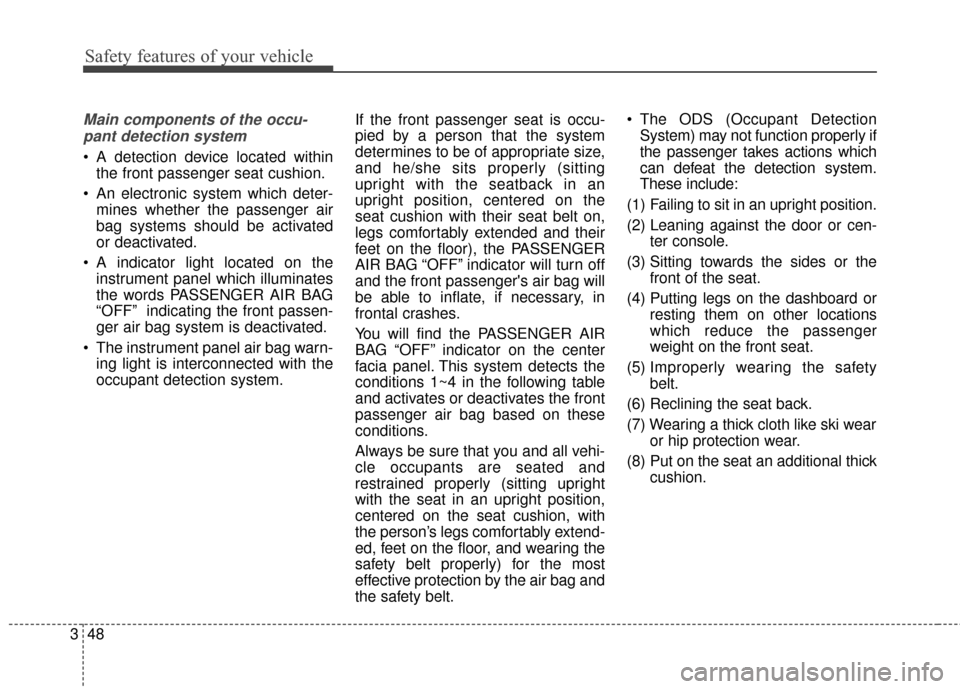
Safety features of your vehicle
48
3
Main components of the occu-
pant detection system
A detection device located within the front passenger seat cushion.
An electronic system which deter- mines whether the passenger air
bag systems should be activated
or deactivated.
A indicator light located on the instrument panel which illuminates
the words PASSENGER AIR BAG
“OFF” indicating the front passen-
ger air bag system is deactivated.
The instrument panel air bag warn- ing light is interconnected with the
occupant detection system. If the front passenger seat is occu-
pied by a person that the system
determines to be of appropriate size,
and he/she sits properly (sitting
upright with the seatback in an
upright position, centered on the
seat cushion with their seat belt on,
legs comfortably extended and their
feet on the floor), the PASSENGER
AIR BAG “OFF” indicator will turn off
and the front passenger's air bag will
be able to inflate, if necessary, in
frontal crashes.
You will find the PASSENGER AIR
BAG “OFF” indicator on the center
facia panel. This system detects the
conditions 1~4 in the following table
and activates or deactivates the front
passenger air bag based on these
conditions.
Always be sure that you and all vehi-
cle occupants are seated and
restrained properly (sitting upright
with the seat in an upright position,
centered on the seat cushion, with
the person’s legs comfortably extend-
ed, feet on the floor, and wearing the
safety belt properly) for the most
effective protection by the air bag and
the safety belt. The ODS (Occupant Detection
System) may not function properly if
the passenger takes actions which
can defeat the detection system.
These include:
(1) Failing to sit in an upright position.
(2) Leaning against the door or cen- ter console.
(3) Sitting towards the sides or the front of the seat.
(4) Putting legs on the dashboard or resting them on other locations
which reduce the passenger
weight on the front seat.
(5) Improperly wear ing the safety
belt.
(6) Reclining the seat back.
(7) Wearing a thick cloth like ski wear or hip protection wear.
(8) Put on the seat an additional thick cushion.
Page 65 of 500
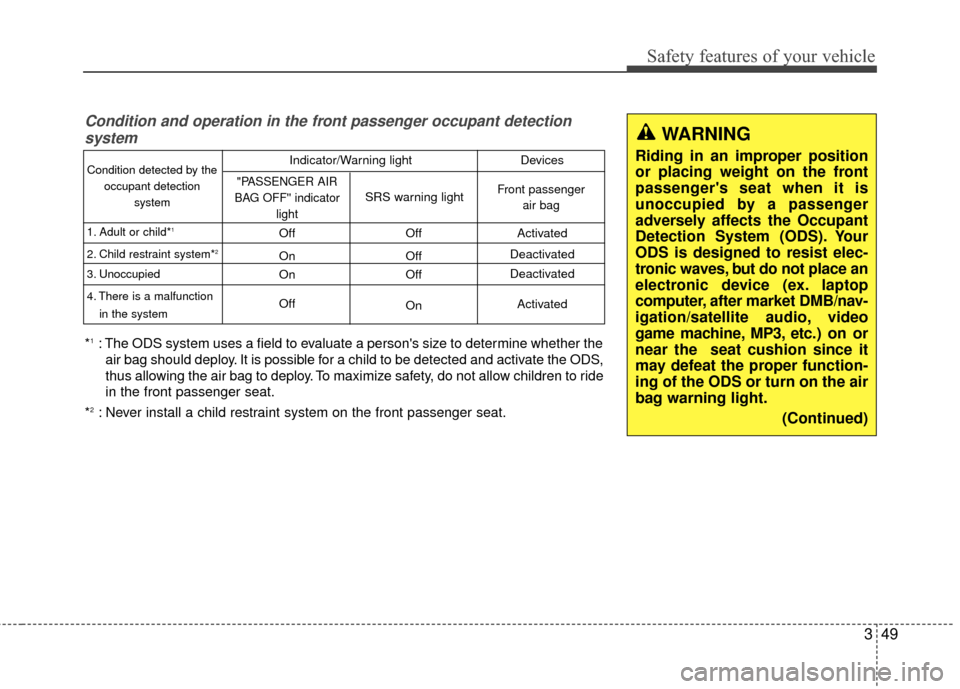
349
Safety features of your vehicle
Condition and operation in the front passenger occupant detectionsystem
*1: The ODS system uses a field to evaluate a person's size to determine whether the
air bag should deploy. It is possible for a child to be detected and activate the ODS,
thus allowing the air bag to deploy. To maximize safety, do not allow children to ride
in the front passenger seat.
*
2: Never install a child restraint system on the front passenger seat.
WARNING
Riding in an improper position
or placing weight on the front
passenger's seat when it is
unoccupied by a passenger
adversely affects the Occupant
Detection System (ODS). Your
ODS is designed to resist elec-
tronic waves, but do not place an
electronic device (ex. laptop
computer, after market DMB/nav-
igation/satellite audio, video
game machine, MP3, etc.) on or
near the seat cushion since it
may defeat the proper function-
ing of the ODS or turn on the air
bag warning light. (Continued)Condition detected by the
occupant detection system
1. Adult or child*
1
2. Child restraint system*2
3. Unoccupied
4. There is a malfunction in the system
Off
On
On
Off Off
Off
Off
OnActivated
Deactivated
Deactivated
Activated
"PASSENGER AIR
BAG OFF" indicator light
SRS warning lightFront passenger air bag
Indicator/Warning light Devices
Page 69 of 500
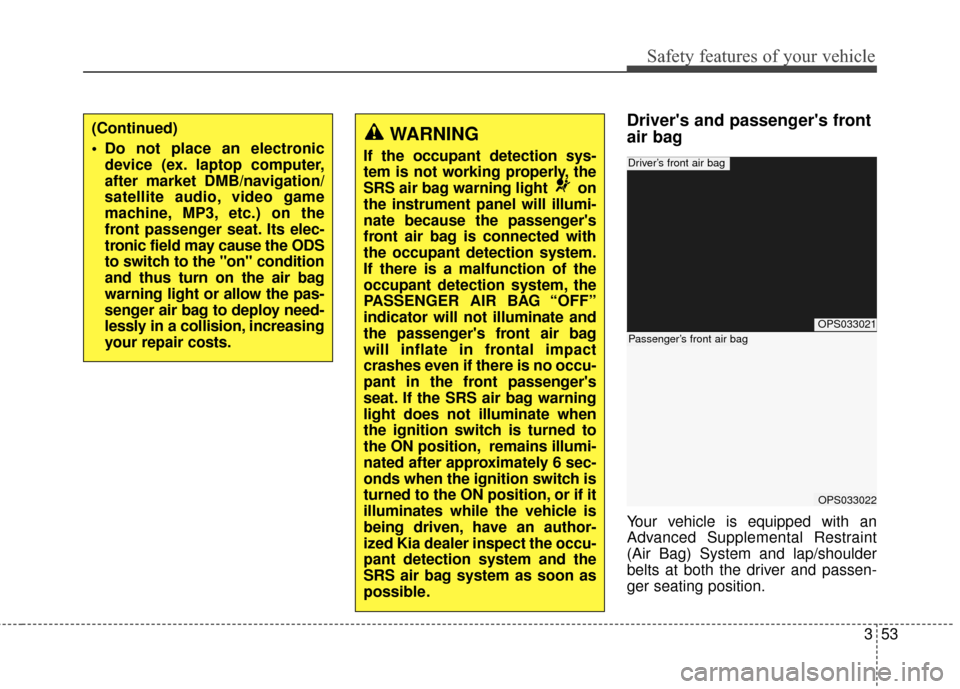
353
Safety features of your vehicle
Driver's and passenger's front
air bag
Your vehicle is equipped with an
Advanced Supplemental Restraint
(Air Bag) System and lap/shoulder
belts at both the driver and passen-
ger seating position.
WARNING
If the occupant detection sys-
tem is not working properly, the
SRS air bag warning light on
the instrument panel will illumi-
nate because the passenger's
front air bag is connected with
the occupant detection system.
If there is a malfunction of the
occupant detection system, the
PASSENGER AIR BAG “OFF”
indicator will not illuminate and
the passenger's front air bag
will inflate in frontal impact
crashes even if there is no occu-
pant in the front passenger's
seat. If the SRS air bag warning
light does not illuminate when
the ignition switch is turned to
the ON position, remains illumi-
nated after approximately 6 sec-
onds when the ignition switch is
turned to the ON position, or if it
illuminates while the vehicle is
being driven, have an author-
ized Kia dealer inspect the occu-
pant detection system and the
SRS air bag system as soon as
possible.
OPS033021
OPS033022
Driver’s front air bag
Passenger’s front air bag
(Continued)
Do not place an electronicdevice (ex. laptop computer,
after market DMB/navigation/
satellite audio, video game
machine, MP3, etc.) on the
front passenger seat. Its elec-
tronic field may cause the ODS
to switch to the "on" condition
and thus turn on the air bag
warning light or allow the pas-
senger air bag to deploy need-
lessly in a collision, increasing
your repair costs.
Page 71 of 500

355
Safety features of your vehicle
Additionally, your vehicle is equipped
with an occupant detection system in
the front passenger's seat. The occu-
pant detection system detects the
presence of a passenger in the front
passenger's seat and will turn off the
front passenger's air bag under cer-
tain conditions. For more detail, see
"Occupant detection system" in this
section.
WARNING
Manufacturers are required by
government regulations to pro-
vide a contact point concerning
modifications to the vehicle for
persons with disabilities, which
modifications may affect the
vehicle’s advanced air bag sys-
tem. However, Kia does not
endorse nor will it support any
changes to any part or structure
of the vehicle that could affect
the advanced air bag system,
including the occupant detec-
tion system.(Continued)
(Continued)
Specifically, the front passenger
seat, dashboard or door should
not be replaced except by an
authorized Kia dealer using
original Kia parts designed for
this vehicle and model. Any
other such replacement or mod-
ification could adversely affect
the operation of the occupant
detection system and your
advanced air bags. For the
same reason, do not attach any-
thing to the seat, dashboard or
door, even temporarily. If the
system is adversely affected, it
could cause severe personal
injuries or death in a collision.
WARNING
Modification to the seat struc-ture can cause the air bag to
deploy at a different level than
should be provided.
Do not place any objects underneath the front seats as
they could damage and/or
interfere with the occupant
detection system.
Page 78 of 500

Safety features of your vehicle
62
3
Why didn’t my air bag go off in a
collision? (Inflation and non-infla-
tion conditions of the air bag)
There are many types of accidents
in which the air bag would not be
expected to provide additional
protection.
These include rear impacts, sec-
ond or third collisions in multiple
impact accidents, as well as low
speed impacts.Air bag collision sensors
(1) SRS control module/Rollover sensor
(2) Front impact sensor (3) Side impact sensor
(4) Side pressure sensor
OPS033025N/OPS033026/OPS033027/OPS033028/OPS033029
1234
Page 79 of 500
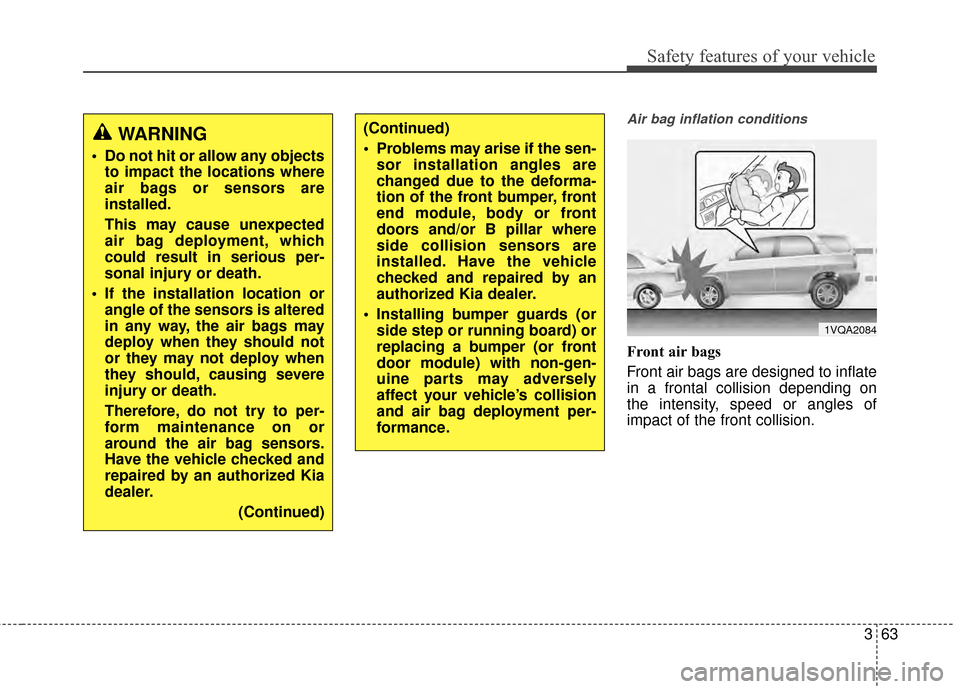
363
Safety features of your vehicle
Air bag inflation conditions
Front air bags
Front air bags are designed to inflate
in a frontal collision depending on
the intensity, speed or angles of
impact of the front collision.
1VQA2084
WARNING
Do not hit or allow any objectsto impact the locations where
air bags or sensors are
installed.
This may cause unexpected
air bag deployment, which
could result in serious per-
sonal injury or death.
If the installation location or angle of the sensors is altered
in any way, the air bags may
deploy when they should not
or they may not deploy when
they should, causing severe
injury or death.
Therefore, do not try to per-
form maintenance on or
around the air bag sensors.
Have the vehicle checked and
repaired by an authorized Kia
dealer.
(Continued)
(Continued)
Problems may arise if the sen-sor installation angles are
changed due to the deforma-
tion of the front bumper, front
end module, body or front
doors and/or B pillar where
side collision sensors are
installed. Have the vehicle
checked and repaired by an
authorized Kia dealer.
Installing bumper guards (or side step or running board) or
replacing a bumper (or front
door module) with non-gen-
uine parts may adversely
affect your vehicle’s collision
and air bag deployment per-
formance.
Page 81 of 500

365
Safety features of your vehicle
Air bag non-inflation conditions
In certain low-speed collisions theair bags may not deploy. The air
bags are designed not to deploy in
such cases because they may not
provide benefits beyond the pro-
tection of the seat belts in such col-
lisions. Air bags are not designed to inflate
in rear collisions, because occu-
pants are moved backward by the
force of the impact. In this case,
inflated air bags would not be able
to provide any additional benefit. Front air bags may not inflate in
side impact collisions, because
occupants move to the direction of
the collision, and thus in side
impacts, frontal air bag deployment
would not provide additional occu-
pant protection.
OUN036087OVQ036018N
1VQA2086